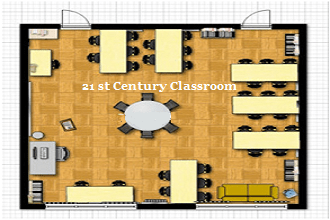It might be hard to believe but yes it has been over a decade since the 21st century began, and for the Y generation it might also be fascinating as to how much has changed within the last 20-30 years or since technology evolved. No one could imagine our phones to be brought down to the light-weight all-touch or that the once room-sized computers would be shrunk down to a PC then to a laptop which can be folded in any way or even converted into a ‘smartphone‘ or ‘tablet’.
Yes we have gone far, and even the classrooms have gone from the chalk and slate to projectors and tablets.
The new design according to technology integration in education is shown in the image.
For 21st Century Learning, the 21st Century classroom is designed with two key concepts in mind: technology access and student-centered architecture. Technology access means that each student should be having their own space to function with technology; the classroom is outfitted with a mounted LCD projector, a document camera and an additional wireless router. By student centered it is clear that each student is being given the center hence In order to create a student-centered environment, the teacher’s desk has been removed and replaced with a podium that can be moved around the room. This design layout is something that we used to find in kindergarten, even though the layout might be similar but it the best as we find that the development and learning in small groups with mobility with the teacher is the maximum.
An interactive whiteboard or IWB is a large interactive display that combines the simplicity of a whiteboard, power of a computer and front projection. This is the latest in the technology equipments found in the new classrooms of the 21st century. Promethean interactive whiteboards engage students with vivid images, video and audio. The interactive whiteboards enables anything that can be seen or done on a computer screen to be projected onto an interactive whiteboard – bringing every classroom to life.
The 21st Century Classroom not only has modern tools, equipment and content but it includes a teacher trained to use the tools effectively with innovative teaching approaches that integrates the interactivity and engaging content technology brings to curriculum. An online learning community provides teachers across schools, school districts and states the opportunity to share resources, highlight strengths and gain supporting weaker areas. The purpose of online learning communities is the opportunity for collaboration in a non‐threatening environment and for teachers to learn and share without time or travel constraints.
And social media is one of the most informative forms of sending and receiving information, even mass media is using social media as a medium of sending and sharing or promoting information. Research indicates that some forms of social media unite groups, while others can fragment communities by reducing face-to-face contacts and group involvements and creating divisive interpersonal and intergroup conflicts. The most popular sites are Twitter, Facebook and LinkedIn.
It is very helpful for teachers as they can use blogs to connect to the students with experts from around the world and provide a world-wide audience for the students to showcase their accomplishments. Blogs can also be used to share “what we are learning” with the colleagues. Sharing with colleagues allows others to learn and our district to grow. In fact, blogging even encourages the kindergarteners and can help support educators around the world. What may be obvious to some might be amazing and innovative to others.
Also students can find material by ‘following’ some great people in their respective fields of interest and get what material they aren’t in class and research on that. Although it goes without saying that the social life and course work should be kept separate, but all in all the 21st century way of education is the way to be educated.


